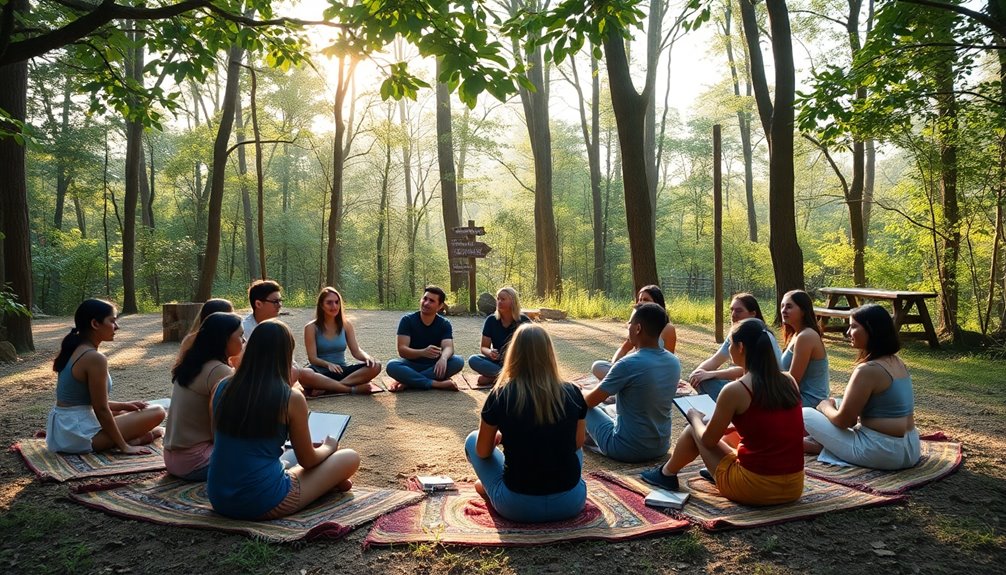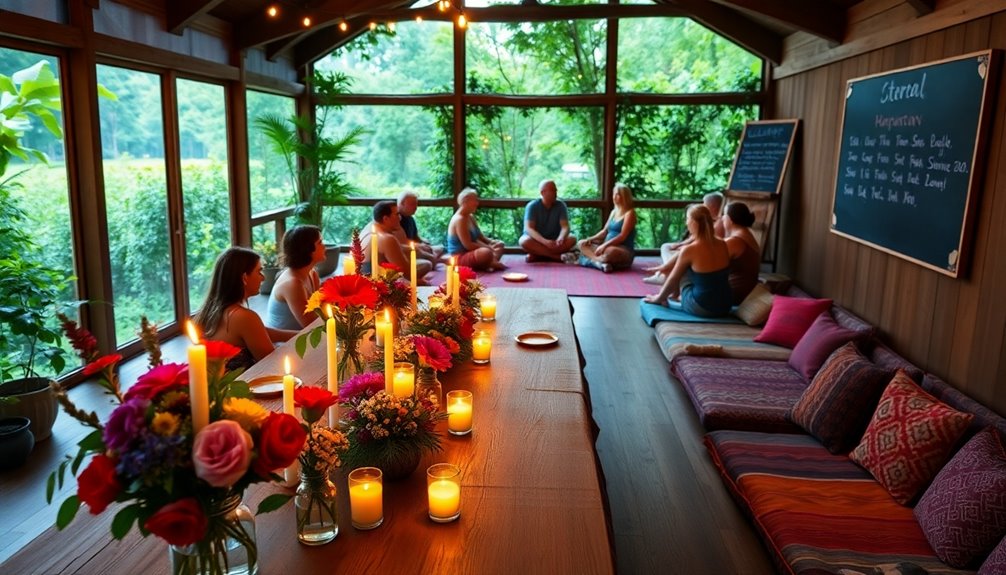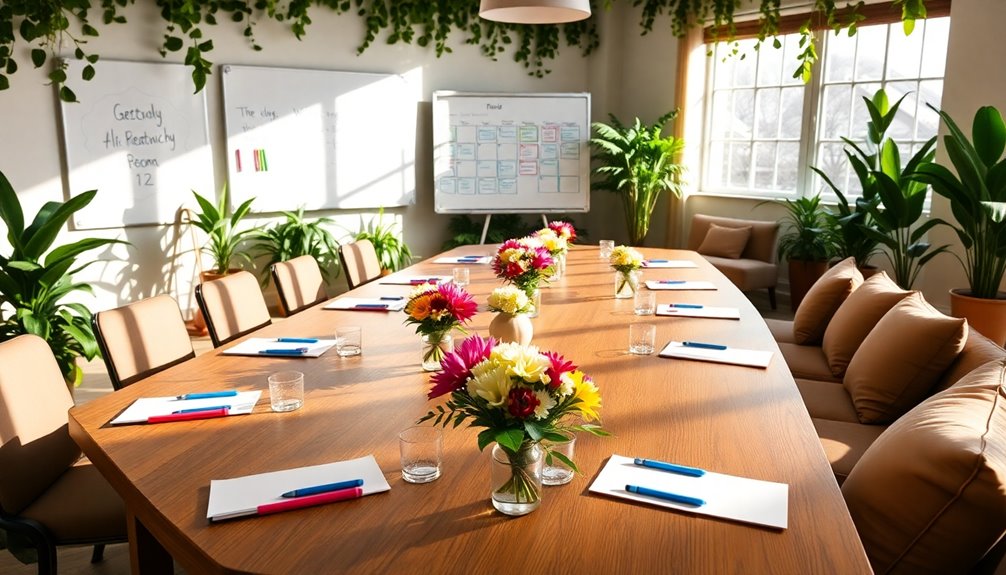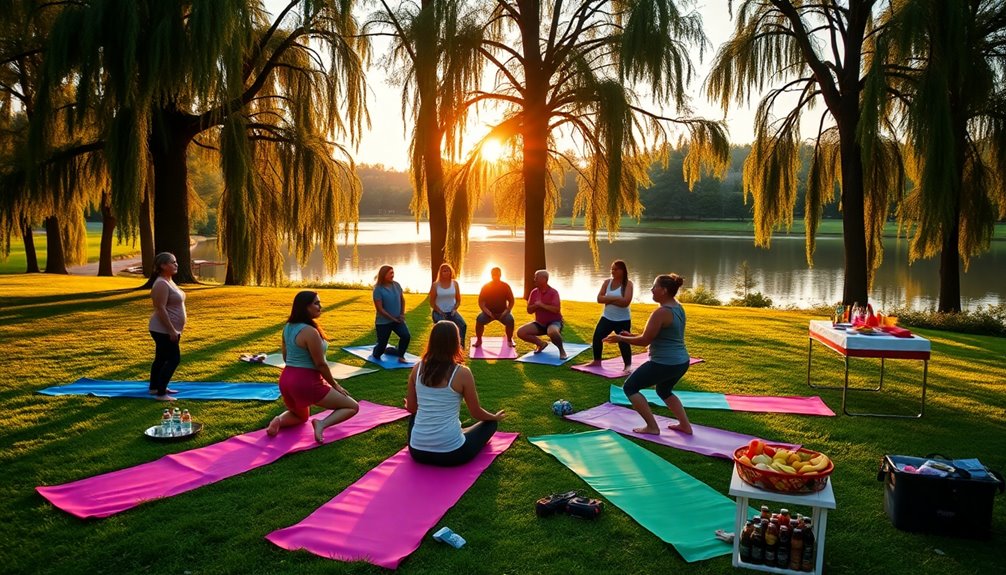To structure a memorable retreat, start by defining your purpose and knowing your audience. Choose a time and location that suits everyone and aligns with your retreat's aims. Build an engaging schedule with a mix of activities, ensuring smooth transitions. Allocate resources wisely, creating a budget that balances costs with quality experiences. Develop a detailed agenda that reflects your goals and includes time for reflection. Finally, add unique elements to enhance participant engagement. Follow these steps, and you'll set the stage for an unforgettable retreat experience, with even more tips waiting for you ahead.
Key Takeaways
- Define the retreat's purpose and target audience to tailor activities and messaging for maximum engagement and alignment.
- Select an appropriate time and location that enhances the retreat experience and meets the needs of the participants.
- Create a balanced schedule that includes structured activities, free time, and unique offerings to keep participants engaged.
- Allocate resources effectively by creating a comprehensive budget and selecting a mix of affordable and premium activities.
- Develop a detailed agenda that aligns with defined goals, incorporates wellness trends, and allows for participant feedback.
Define Purpose and Audience

When you set out to organize a retreat, it's essential to clarify its purpose and identify your audience. Start by defining a clear vision; pinpoint why you're bringing people together. Establish specific objectives that create a strong sense of purpose, ensuring every activity aligns with your overall theme.
Next, identify your target audience. Consider their demographics, like age and location, and dive into their values and interests through market research, surveys, or online engagement. This insight allows you to tailor your messaging and offerings, making sure they resonate. Furthermore, understanding the benefits of retreats can help you emphasize the unique experiences your retreat will offer to participants.
Choose Time and Location

Choosing the right time and location for your retreat is crucial to its success, as it sets the stage for participant engagement and satisfaction.
First, consider your group size; smaller gatherings thrive in intimate settings, while larger groups need spacious venues. Additionally, the zoning laws in the area can impact the types of venues available for your retreat.
Think about seasonal activities too—summer retreats might focus on outdoor fun, while winter ones can embrace cozy indoor options.
Evaluate the purpose of your retreat: a celebration may call for a vibrant city, while team bonding suits a tranquil, natural setting. Furthermore, aligning your choice with the retreat vision ensures that the environment supports the overall objectives of the experience.
Lastly, check the venue's amenities and facilities to ensure they meet your specific needs. All these factors combined will help create the ideal environment for a memorable retreat experience.
Build an Engaging Schedule

Crafting an engaging schedule is essential for maximizing the impact of your retreat, as it directly influences participant involvement and satisfaction. Start by defining clear objectives and aligning them with SMART goals that resonate with attendees. A detailed agenda is crucial; balance structured programming with free time for relaxation and reflection. Ensure smooth transitions between activities to maintain engagement and include a variety of activities, such as interactive workshops and team-building exercises. Incorporating feedback collection will help you understand participant needs and preferences for future events. Don't forget to allow for break times and incorporate unique elements like quiet hours or sound healing. Finally, gather feedback from previous retreats, consider participant preferences, and maintain flexibility in your schedule to adapt to any changes. This approach will create a truly memorable experience.
Allocate Resources Effectively

Effective resource allocation is crucial for the success of your retreat, as it ensures that every aspect aligns with your goals and stays within budget.
Start by setting realistic financial parameters; define your retreat's objectives and create a comprehensive budget covering accommodation, transportation, meals, and activities. Indexed annuities can be an effective way to secure funds for future retreats, providing a stable income stream.
Consider planning during off-peak seasons to secure better rates, and don't hesitate to negotiate group discounts. Additionally, effective budgeting helps prevent overspending and resource misallocation.
Optimize accommodation by selecting venues near airports and exploring local meeting spaces.
Utilize in-house expertise for workshops and mix low-cost activities with higher-priced ones.
Finally, appoint a dedicated point person to track budget allocation and maintain flexibility, allowing you to adapt to changes and maximize every dollar spent.
Develop a Detailed Agenda

After you've allocated your resources wisely, the next step is to develop a detailed agenda that captivates and engages your participants. Start by defining your retreat's goals and theme, ensuring all activities align with them.
Set clear, SMART objectives and tailor the agenda to your audience's needs. Structure the program thoughtfully, balancing sessions with free time for reflection. Incorporate a variety of activities to cater to diverse preferences, and ensure to include breaks for rest. Additionally, consider the growing trend of wellness tourism, as it emphasizes the importance of personal health and can influence your agenda planning. Implementing elements of renewable energy solutions can also enhance the experience, promoting sustainability and consciousness among participants.
Assign a coordinator to oversee the flow and transitions, maintaining energy throughout. Finally, review the agenda with stakeholders and send out the finalized version to participants, so they're well-prepared for a memorable experience.
Plan Activities for Engagement

To create a truly engaging retreat, you’ll want to plan activities that not only align with your objectives but also foster connections among participants. Choose inclusive activities that cater to everyone’s needs and incorporate a variety of structured workshops and fun bonding exercises. Team-building activities enhance collaboration and idea-sharing, so make those a priority. Ensure each activity aligns with your retreat goals, mixing educational topics with interactive sessions to keep everyone engaged. For shorter retreats, focus on concise, impactful activities, while longer retreats can delve deeper into professional development. Organize activities with clear expectations and schedule them to allow for smooth transitions. Additionally, consider incorporating Montessori-inspired approaches to foster independence and creativity among participants. Finally, prioritize participant comfort to ensure everyone feels involved and valued. Furthermore, incorporating team dynamics into your activities can significantly boost engagement and creativity during the retreat. Additionally, integrating leadership development activities for students can further enhance the experience by equipping young participants with essential skills for their future endeavors. These activities not only promote personal growth but also encourage teamwork and critical thinking among peers. By providing a platform for students to take on leadership roles, you create a dynamic learning environment that fosters self-confidence and innovation.
Frequently Asked Questions
How Do I Evaluate the Success of the Retreat?
To evaluate the success of your retreat, start by establishing clear, measurable goals aligned with your overall objectives.
Gather feedback through surveys and one-on-one meetings to understand participants' experiences.
Analyze participation data to identify popular activities and trends.
Conduct a debriefing session with your team to discuss what worked and what didn't.
Finally, document lessons learned and make recommendations for future retreats to continuously improve the experience.
What Should I Do if Participants Have Conflicting Preferences?
Imagine a garden where every flower blooms differently, yet they thrive together.
When you face conflicting preferences, gather everyone's thoughts through surveys and discussions. Create a flexible schedule that accommodates diverse needs, like sunlight for each flower.
Manage dietary restrictions with a colorful menu, ensuring everyone finds something they enjoy.
Lastly, embrace conflict as a chance for growth; encourage open dialogue and teamwork, cultivating a vibrant and united experience for all participants.
How Can I Handle Unexpected Issues During the Retreat?
When unexpected issues arise during your retreat, stay calm and assess the situation.
Communicate openly with your guests, addressing their concerns and providing updates.
Ensure you've got a crisis plan in place and assign a point person for coordination.
Remember to prioritize safety and well-being by having emergency contacts and resources readily available.
Afterward, conduct a debriefing to evaluate your response and improve future retreats.
Flexibility and preparation are key!
What Follow-Up Activities Can Maintain Engagement Post-Retreat?
To keep the fire burning after your retreat, plan follow-up activities that engage attendees.
Organize a follow-up event within two weeks to revisit techniques and gather feedback.
Create opportunities for collaboration by sharing contact info and encouraging social media connections.
Send personalized thank-you messages to make everyone feel valued.
Lastly, host virtual meetups to foster community and enhance skills, ensuring your participants stay connected and invested in their growth.
How Do I Foster Connections Among Participants During the Retreat?
To foster connections among participants during the retreat, start with icebreakers to create a relaxed atmosphere.
Encourage group discussions where everyone shares their thoughts and experiences, promoting open communication.
Organize small group activities for intimate conversations and collaboration.
Emphasize a non-competitive environment, fostering a supportive community.
Finally, encourage active participation and positive feedback, helping participants bond and build lasting connections throughout the retreat.
Conclusion
By thoughtfully structuring your retreat, you're setting the stage for an unforgettable experience. Keep your purpose and audience in mind, and don't forget to sprinkle in a few engaging activities that'll have everyone feeling like they're on a wild adventure, not just a corporate getaway. With careful planning, you'll create a space where connections flourish, ideas ignite, and memories are made—like a modern-day Woodstock for productivity and creativity! So, go ahead and make it happen!









